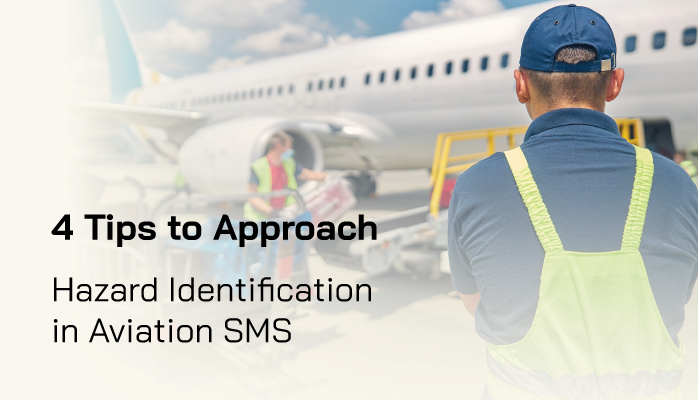How Do We Define Hazard Identification in Aviation SMS

Like the concept of safety culture, hazard identification in aviation safety management systems (SMS) is usually taken at face value: it’s just something that happens or doesn’t happen.
While the concept of hazard identification – literally just the awareness of hazards within a system – is very simple, understanding the process of hazard identification is significantly more complex and requires careful consideration.
This consideration is threefold:
- What is your approach(es) to hazard identification?
- What are the advantages of your approach(es)?
- How do you improve your approach(es)?
Related Articles on Aviation Hazard Identification
- 4 Pillars | What Is Hazard Identification in Aviation SMS
- Safety Chart: Monitoring Hazard Identification and Safety Reporting Culture Per Division
- FAA Part 5 Compliance | Safety Risk Management Hazard Identification Requirement
I can already imagine some of you thinking, "Well the best approach is a combination of many different approaches. Well, frankly – no – that is an erroneous assumption. Different systems will have different needs, and certain approaches to risk identification will be better tailored for different environments.
Granted, having a well-rounded risk management program is important, but not at the expense of ignoring that your SMS' specific needs require some custom-tailored approaches. Moreover, as you well know, time and resources are ever limited in aviation SMS, and it’s simply not feasible to adopt the combo approach. Here are 4 approaches with tips as to the advantages and disadvantages of each one.
1 – Data-Driven Hazard Identification in SMS (Predictive)
Data-driven Hazard Identification is a fantastic way to make use of your Lagging Indicators, which are the performance data and “output” of your SMS. It simply involves:
- Thorough analysis of your aviation SMS' safety data;
- Identification of themes in Key Risk Indicator (aka key performance indicators) root causes; and
- Creating policies and procedures based on the analysis and identification.
Advantages:
- Extremely functional in the sense that it deals with actual, historical realities; and
- Hones in on the specific, historically based safety needs of the organization.
Disadvantages:
- Susceptible to being unprepared for new hazards (past success/failure is not a future guarantee); and
- Is only ever as prepared as the quality of the safety culture, as this method relies exclusively on the involvement (e.g. hazard reporting) of employees.
Ideal for programs in phase 3 of aviation SMS implementation who are looking to solidify the baseline safety (output) of the program in anticipation of venturing into more proactive or SWIFT-like methods of risk identification. You will notice two key aviation risk management terms that key you into data management requirements, namely:
- Predictive; and
- Proactive.
Data-driven hazard identification is a predictive risk management activity to identify trends or problem areas based on historical data to predict and prepare for future events.
Related Aviation Predictive Risk Management Articles
- Difference Between Reactive, Predictive and Proactive Risk Management in Aviation SMS
- How to Practice Reactive, Proactive, and Predictive Risk Management in Your Safety Program
- Going From Reactive to Predictive Risk Management in Aviation SMS
2 – “Structured What If” SWIFT Approach to Identifying Hazards (Proactive)
The Structured What If (SWIFT) approach to hazard identification is the daydreamer's ideal method. This method is self-explanatory – it is basically a core team and safety director who sit down and approach situations with a small list of prompts, such as:
- What if X happens…?
- What are the chances of Y happening…?
- What would be the best approach to managing Z situation.
Frankly, I see little difference between this and “brainstorming,” except that SWIFT seems to approach situations with some structured prompts whereas brainstorming is more of an open conversation. Either way, they seem to amount to the same advantages.
Essentially, this method involves taking scenarios the company could reasonably expect to arise at some point and preparing a record of how to deal with that scenario. Whereas FMEA looks at specific failures in the system, SWIFT is really accounting for safety scenarios in which multiple failures have lined up (i.e. Swiss Cheese).
Advantages:
- Creates a detailed record of how to deal with any number of situations;
- Great for identifying novel hazards; and
- Easy and inexpensive way to quickly create many different controls in the program against hypothetical situations.
Disadvantages:
- Very careful thought and strong leadership/knowledge is required on the part of the safety director – relies heavily on his/her skill set;
- Susceptible to the bias and profiles of participants; and
- Has potential for very weak controls (and therefore a false sense of SMS security) if each situation is not very carefully considered.
Great for new programs (which usually entail small budgets), to quickly assemble controls and procedures.
Related Aviation Proactive Risk Management Articles
- What Is Proactive Risk Management in Aviation SMS?
- Proactive Risk Management: What Root Causes Say About Management
- The Secret Bias That Hurts Proactive Risk Management
3 – Community Approach to SMS Hazard Identification (Performing)

Failure Modes and Effects Analysis (FMEA) ties in closely with the community approach. This approach relies on a “bottom-up” technique for identifying hazards within the safety management system.
Group approach and FMEA rely on looking at the many different ways base-level parts of the system could fail and reverberate through the system – such as equipment failures or failures of functions of the system (e.g. an employee’s role in the program). It also attempts to ensure that the failure will be recognized because the group is well prepared. It’s essentially a performing method of hazard identification, as it relies on the abilities of front-line employees to recognize and react to base-level failures in the system – base-level failures which are essential precursors to larger problems.
Advantages:
- Applicable to many different needs and organizational SMS programs;
- Can be a rigorous defense against hazards; and
- Involves employees and can adapt to many situations.
Disadvantages:
- Relies on experience and system knowledge of the group;
- Can be vulnerable to many different failures in the system “lining up,” as it focuses on identifying single instances of failures; and
- Training employees and Effects Analysis can be costly and time-consuming.
Ideal for larger, well-established SMS with experienced employees, as such programs will have the financial and personal resources to nip hazards in the bud early. Healthy, mature safety cultures perform better using the community, "bottom-up" approach as there is less resistance and more active participation in the SMS.
Related Articles on Aviation SMS Safety Cultures
- What Is Safety Culture in the Aviation Industry?
- 5 Characteristics of Effective Aviation Safety Cultures - With Free Survey
- How Top Management Kills Your Aviation Safety Culture
4 – Leadership Approach to Identifying Hazards (Top-Down)
The leadership approach to identifying hazards empowers highly knowledgeable individuals, such as a safety team, to act as risk-vigilantes in the program. Such individuals would be involved in all aspects of the system and would be responsible for identifying many of the hazards that arise within the SMS.
These safety leaders would be tasked with not only having a wide range of knowledge for hazards as they arose but would also need to have keen eyes for precursors.
Advantages:
- Ensures that all functional parts of the risk management program have a strong safety leader to watch for hazards; and
- Gives employees a safety backstop, allowing them to focus on their specific tasks (as opposed to also watching out for the safety of other employees' actions).
Disadvantages:
- In poor aviation safety cultures the safety leaders will be easily overwhelmed; and
- Can also give incentives for employees to not make the safest decisions.
Possibly ideal for smaller, tight-knit organizations with an employee base that is comprised of specialists with low employee turnover.
Final Thoughts on Hazard Identification
As you have seen, there is more than one way to approach hazard identification in aviation SMS. There are a couple of other approaches that bear mentioning, but we won't cover them here.
During the system analysis phase of SMS implementation, you are describing your system in an effort to "kick loose" ideas to list hazards during the proactive hazard identification activities. This can turn into a monumental task for new aviation SMS. Once hazards are identified, risk scenarios are reviewed and risk controls are evaluated to ensure risk remains acceptable.
The other approach occurs during the Management of Change activities. When proposed organizational change prompts a new Management of Change project, affected systems are evaluated to ensure new hazards are not introduced into the system and that existing hazards' associated risks remain acceptable.
We hope these ideas are helpful to your organization in identifying hazards and reducing risk.
Employees need easy, flexible methods to report identified hazards. These short videos offer insight into how you can improve your hazard identification and hazard reporting program.
Ready for a Live Demo of an SMS database?
After watching the above videos, you may have questions that can be answered in a live meeting.
Reviewing Hazard Reporting Systems
Aviation hazard reporting systems are a core element of your safety assurance process, as they provide the primary method operators collect data and address safety issues. This checklist helps you review your hazard reporting system to determine possible shortcomings.
Last updated July 2025.








